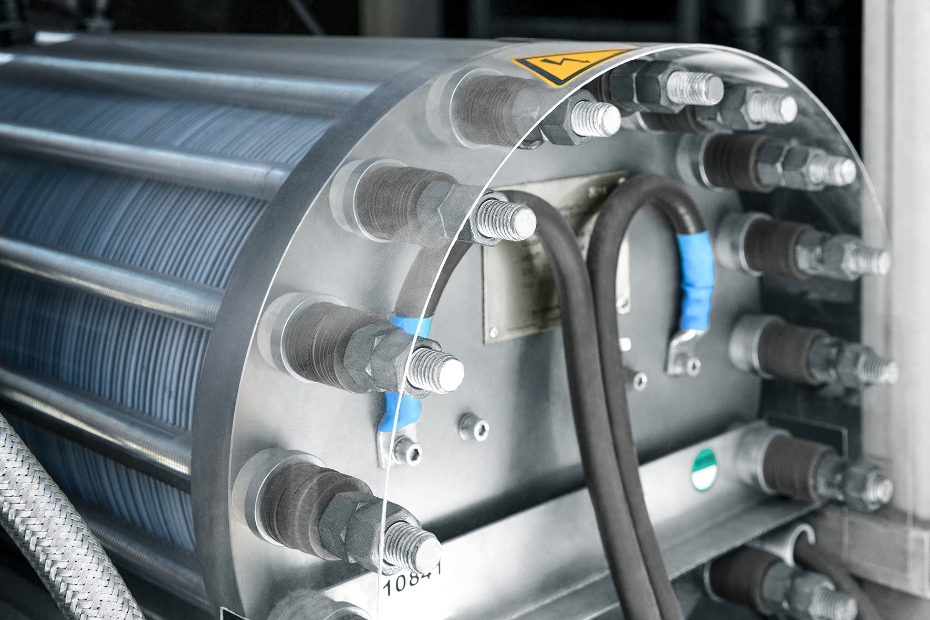Ostfildern-Kemnat, Germany. Automated production of an electrolyser stack with a capacity of one megawatt is around six times faster than manual assembly. However, the task of sealing the bipolar plates, the individual cells and the stack as a whole poses a major challenge. If complete or partial automation is to be achieved, the flat gaskets and O-rings often used must be replaced with an alternative sealing method. To this end, WEVO-CHEMIE GmbH has developed innovative materials that are applied as liquid sealants and adhesives. These bring three key benefits: a high degree of chemical resistance, low hydrogen permeation and good adhesion properties. All three have been verified by leading research institutes and in customer projects. Polyurethanes, epoxy resins and silicones from Wevo open up new possibilities for alkaline and AEM as well as PEM electrolysers, as for example in the design of stacks.
In alkaline electrolysis systems, the hot potassium hydroxide solution (30 to 35 per cent aqueous KOH solution at a temperature of 80 to 90 °C) used as the electrolyte creates challenging ambient conditions. The newly developed Wevo materials, based on modified polyurethanes, epoxy resins and silicones, enable innovative solutions for, among other things, sealing, stack design and automated production for this technology. The materials are also increasingly being used for AEM (Anion Exchange Membrane) electrolysers, where the requirements are high, too – despite the much lower concentration of KOH solution in comparison.
Materials for alkaline and AEM electrolysers
As sealing materials for bipolar plates, individual stack cells and the entire stack, the new Wevo epoxy resin systems offer especially high chemical resistance. This has been confirmed by immersing test specimens in a 35 per cent aqueous potassium hydroxide solution at 90 °C for several weeks. The subsequent examination showed a very low weight loss of
Due to its low viscosity, WEVOPOX 30010 is also suitable as a potting compound in the production of flow frames. This opens up completely new and customisable options for the design of the individual cells and the complete stack. Cell components such as electrode or membrane foils can be connected to the frame seamlessly and completely tightly – without there being any need for additional gaskets or adhesives.
Materials for PEM electrolysers
In the field of PEM (Proton Exchange Membrane) electrolysers, Wevo’s developers make use of the knowledge gained in recent years in the development of sealants for PEM fuel cells.
For sealing the components of the electrolyser stack addition-curing silicones or modified polyurethanes have been developed. Thixotropic silicone systems offering very high resistance levels are available for the acidic conditions. The elasticity and elongation of these materials can also be adjusted over a wide range, allowing individual adaptation to the structure and operating pressure of the respective electrolyser. Elastomer materials with a Shore A hardness in the range of 60–70 include the soft and elastic silicone sealant WEVOSIL 28001 and the thixotropic version WEVOSIL 18001 T. Wevo’s portfolio already offers various solutions for the Shore A 30–40 range, including a soft and elastic and a thixotropic version – WEVOSIL 28002 and 28102, respectively. Due to their special chemical composition, these two sealing materials are characterised above all by what is a very low level of hydrogen permeability for silicones. The hydrogen permeation coefficients measured at ZBT are approximately 130 10E-8 cm²/s for WEVOSIL 28002 and around 220 10E-8 cm²/s for WEVOSIL 28102. Addition-curing silicones are typically in the range of around 500 to over 1000.
Furthermore, the silicone products mentioned and the modified polyurethanes are free from per- and polyfluoroalkyl substances (PFAS) and therefore represent an alternative to the FKM (Fluorine Kautschuk Materials) frequently used as inlay gaskets to date. By switching over early, it is possible to avoid the impact of any future ban on PFAS.
Application by dispensing or screen-printing
During automated production, the materials are applied as a liquid using a dispensing or screen-printing process – and hardened as a CIPG (cured-in-place gasket) or FIPG (formed-in-place gasket) prior to the stacking process, depending on customer requirements.
In order to enable Wevo’s silicone materials to be used with the faster of these two processes, screen-printing, their pot life has been modified (WEVOSIL 18001, 18002, 18102 and 18001 T): it is at least 24 hours at room temperature, which means that the materials can be used on the screen and screen-printing machine without the need for intermediate cleaning. Fast curing is then carried out either in a convection oven at temperatures between 100 and 140 °C or using near-infrared radiators. The two curing methods can also be combined.
Thanks to its long pot life, a soft and elastic isocyanate-free and therefore label-free polyurethane sealant can also be applied using the screen-printing process. Wevo’s developers are also currently working on a more reactive version, with a shorter pot life and curing time, that can be used with the dispensing process.
Image source: © jeremyiswild – istockphoto.com
